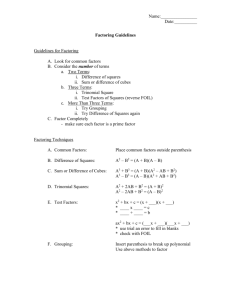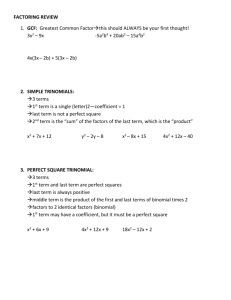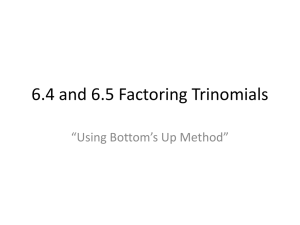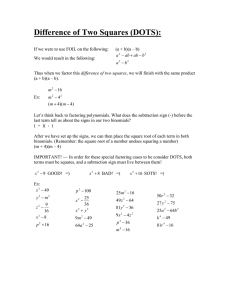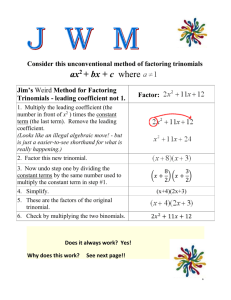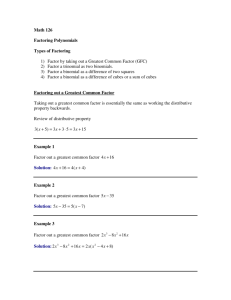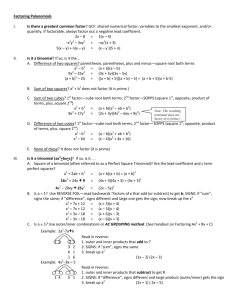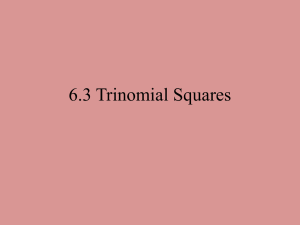Rules of Factoring: First Rule of Factoring Count your terms! If you
advertisement
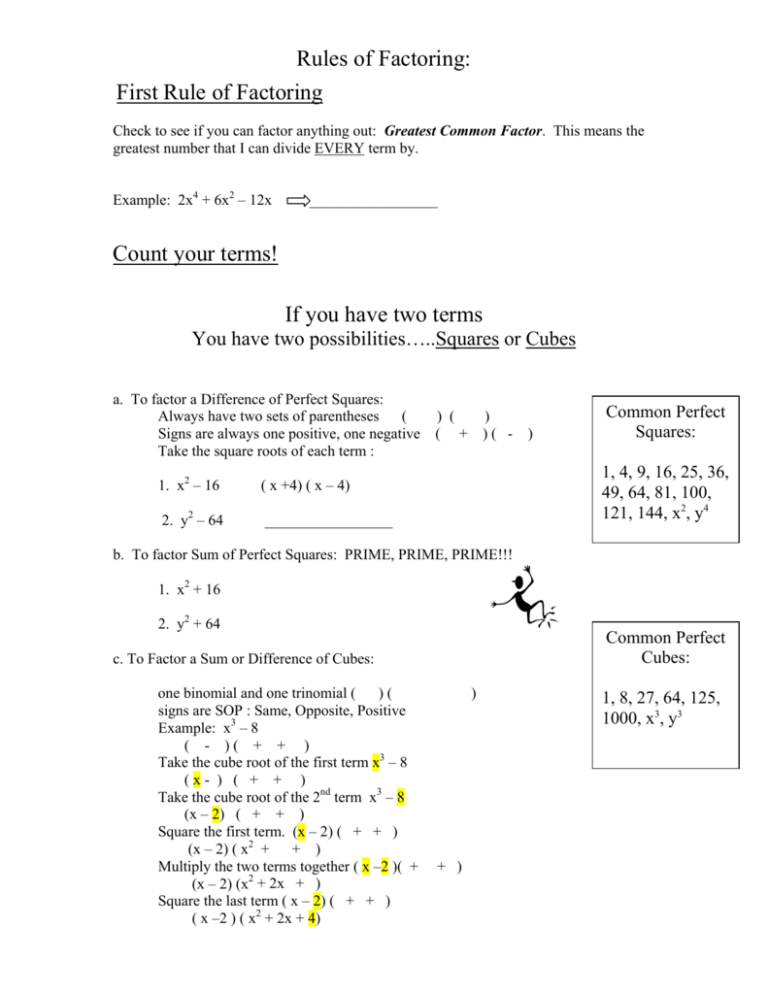
Rules of Factoring: First Rule of Factoring Check to see if you can factor anything out: Greatest Common Factor. This means the greatest number that I can divide EVERY term by. Example: 2x4 + 6x2 – 12x _________________ Count your terms! If you have two terms You have two possibilities…..Squares or Cubes a. To factor a Difference of Perfect Squares: Always have two sets of parentheses ( ) ( ) Signs are always one positive, one negative ( + ) ( - ) Take the square roots of each term : 1. x2 – 16 ( x +4) ( x – 4) 2. y2 – 64 _________________ Common Perfect Squares: 1, 4, 9, 16, 25, 36, 49, 64, 81, 100, 121, 144, x2, y4 b. To factor Sum of Perfect Squares: PRIME, PRIME, PRIME!!! 1. x2 + 16 2. y2 + 64 Common Perfect Cubes: c. To Factor a Sum or Difference of Cubes: one binomial and one trinomial ( ) ( signs are SOP : Same, Opposite, Positive Example: x3 – 8 ( - )( + + ) Take the cube root of the first term x3 – 8 (x- ) ( + + ) Take the cube root of the 2nd term x3 – 8 (x – 2) ( + + ) Square the first term. (x – 2) ( + + ) (x – 2) ( x2 + + ) Multiply the two terms together ( x –2 )( + (x – 2) (x2 + 2x + ) Square the last term ( x – 2) ( + + ) ( x –2 ) ( x2 + 2x + 4) ) + ) 1, 8, 27, 64, 125, 1000, x3, y3 If you have Three terms: Trinomials! To factor a trinomial: Check to see if the terms are IN ORDER (Ascending or Descending) Check to see if its an “Easy” or “Hard” Trinomial a. Easy trinomial: Always have two sets of parenthesis ( ) ( ) To determine the signs look at the last term: x2 –6x + 9 ( - )( - ) If it is positive, then look at the second term. Both signs are whatever the second terms signs are. 2 x + 6x + 9 ( + )( + ) x2 – 4x - 12 ( + )( - ) If the third term is negative. The signs in the two binomials are one positive and one negative. It does not matter what the other signs are. Ask yourself the famous question “What two numbers multiply together to give me the last term but add together to give me the middle term?” Ex: x2 – 4x – 12 -6 * 2 = -12 and -6 + 2 = -4 so the answer is (x – 6 ) (x + 2) Use Foil to check your answer! b. Hard Trinomials Always have two sets of parenthesis ( Determine your signs. )( ) You can use trial and error to figure out what numbers go in the binomials. Keep in mind you always have to be able to use the foil method and get exactly what you started with. Ex. (4x2 – 17x + 15) (___ - ( - ) ( ___ - ___ ) ( ) First terms must multiply together to give you 4x2 Possible factors are 2x * 2x or 4x * x - ___ ) Last terms must multiply together to give you 15 Possible factors are 15 * 1 or 5 * 3 Your outside and inside terms must add together to give you your middle term of -17x. Be careful with your signs. Final answer: (4x - 5)(x – 3) = 4x2 – 12x – 5x + 15 = 4x2 – 17x + 15 If you have Four terms: Grouping! Be careful when the third term is negative. Include the negative in the grouping and ALWAYS factor a negative out. x3 + 7x – 3x2 – 21 (x3 + 7x) + (-3x2 – 21) x x -3 -3 x(x2 + 7) -3(x2 + 7) (x2 + 7) (x2 + 7) (x2 + 7) (x-3) The last thing you do: Make sure nothing can be factored further!

